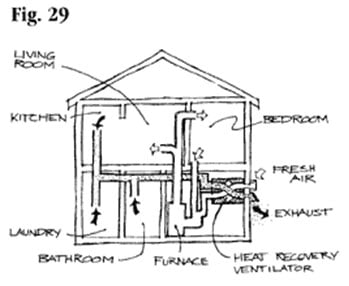What is the ideal humidity level in your home?
A certain amount of humidity in your home is desirable for comfort during the colder months. Windows, doors and skylights that are not energy efficient will often collect condensation or frost even when the indoor humidity is at a reasonable level. Besides obscuring the view, this condensation can lead to mould formation on the frames and sashes.
![]() With an energy-efficient ENERGY STAR® qualified product, it will take a higher indoor humidity for condensation to form.
With an energy-efficient ENERGY STAR® qualified product, it will take a higher indoor humidity for condensation to form.
With well-controlled humidity in your home, you may even be able to turn down your thermostat and still feel comfortable. Because humidity levels are normally higher in bathrooms and kitchens, consider installing an appropriate ENERGY STAR labelled product in these rooms to reduce or eliminate condensation on windows.
Condensation Chart: Maximum Humidity Before Window Condensation Occurs |
||
| Outside Temperature | Standard Window | Energy-Efficient Window |
|---|---|---|
| 0°C | 50% | 63% |
| –10°C | 38% | 50% |
| –20°C | 26% | 40% |
| –30°C | 18% | 30% |
| –40°C | 12% | 23% |
Be aware that high indoor humidity can lead to the formation of mould in areas of the house other than the windows, doors or skylights.
 Controlling the relative humidity of indoor air
Controlling the relative humidity of indoor air
If there are signs of excessive humidity in your house, you should increase ventilation. If you have a problem only once or twice during the winter, you can reduce or eliminate the problem by briefly opening two windows located on opposite walls or by turning on a kitchen or bathroom exhaust fan. If your home has persistent condensation problems, think about installing a controlled mechanical ventilation system. Try to use a system that incorporates a heat recovery unit and controls relative humidity control.
Humidity Reduction Tips
- Disconnect humidifiers that are either fixed to your heating system or are portable.
- Make sure that the clothes dryer is vented to the outside.
- Use bathroom and kitchen fans that vent to the outside when bathing or cooking.
- If you have a crawl space under your house, cover the beaten earth with 0.15 mm (6 mil) polyethylene. The crawl space may have to be ventilated during the summer.
- Make sure that your basement is well drained and protected against excess moisture, and make sure that gutters and the slope of the land around the house drain water away from the house.
- Store firewood outside.
- Some airtight houses were built without mechanical ventilation systems. If high humidity is a chronic problem, consider having a heat recovery ventilator system (HRV) installed.
- If you have a mechanical ventilation system, make sure that it is working properly and that it is turned on.
The ENERGY STAR name and symbol are administered and promoted in Canada by Natural Resources Canada and are registered in Canada by the United States Environmental Protection Agency.